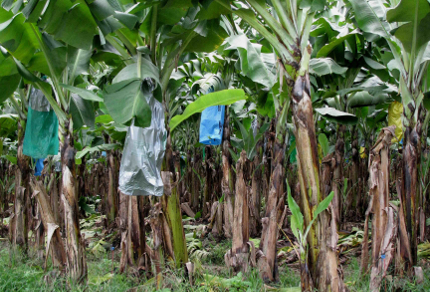
Banana Plantation with Bunch Covers near Innisfail, North Queensland (© Vilis Nams)
In the freshness of early morning, I cycled through the Ross River Parkway past Gleeson’s Weir and found the connection with the more westerly section of the parkway that in Thuringowa is named Riverway. A few homes I passed had banana plants growing in their yards, which reminded me of the clusters of banana plants in the Townsville Community Garden (see http://maginams.ca//2010/01/06/) and of the banana plantations that fascinated Vilis, Janis, and me during our travels in the Tully to Innisfail region of North Queensland last weekend. We were particularly intrigued by the bunch bags covering the fruits, and by harvesters cutting bunches of bananas with machetes and hauling them on a tractor-pulled wagon to a storage shed in which long, thick bunches of bananas hung from metal supports. (see http://maginams.ca//2010/05/01/ and http://maginams.ca//2010/05/03/)
Banana plants are the largest flowering herbaceous plants in the world.6 Native wild species of bananas occur in the rainforests of North Queensland,1 a fact that surprises me, but shouldn’t, given the incredible diversity of the wet tropics. Chinese migrants began farming bananas in Australia in the early to mid-1800’s,2 with the industry really taking off in the 1880’s.2 Now, about 800 banana growers2 in Queensland, New South Wales, Western Australia, and the Northern Territory3 produce over 175,000 tonnes of bananas each year,2 with a gross value exceeding 325 million dollars.2 Queensland produces the lion’s share of the country’s banana crop3, nearly all of which is consumed domestically.2 Bananas are available all year round, and on average an Aussie eats 13 kilograms of bananas a year.2 When I shopped for bananas this week, I noticed that the price of non-specialty bananas had dropped by nearly 50% during the past week, perhaps as a result of the recent banana harvests near Innisfail.
Banana plants thrive in rich, well-drained soils in regions that receive a steady source of rain and maintain warm temperatures of around 27°C2,4; hence the abundance of banana plantations in North Queensland’s coastal wet tropics region. The bananas grow from small suckers into mature plants in 8-14 months.2 Each trunk produces one long, large bunch of bananas consisting of ‘hands’ of bananas containing 10-20 ‘fingers’ or individual bananas.4 Commercial growers cover the developing bananas with plastic bunch covers, which protect the fruits from insects, diseases, sunburn, and damage caused by avian and mammalian marauders – including nectar-feeding birds and bats forging from banana flowers.2,4

Commercial Bananas, clockwise from top – Eco-Bananas Dipped in Red Wax, Lady Finger, Sugar Bananas, Cavendish (© Magi Nams)
Cavendish bananas are the typical long bananas sold in grocery stores, and in Australia account for 95% of the banana market.2 However, smaller, sweeter bananas such as Lady Finger and sugar bananas are available, as are Eco-Bananas grown near Innisfail. The last are the Cavendish variety grown without soil insecticides, nematicides or miticides, without injecting insecticides into the banana bell, and with minimal fertilizers.5 Other Australian commercial bananas include a red variety and plantain, with the latter being hard and starchy and requiring cooking before eating.7
I taste-tested the four banana types I’d bought, with the following results. The thin-skinned sugar banana possessed a very creamy texture, with a slight crunch provided by tiny seeds. Its flavour was distinctly sweet with a refreshing tanginess I hadn’t expected. The Lady Finger, too, was creamy, sweet, and slightly tangy. I’d never before tasted bananas as creamy as those two, nor with their tanginess. The Eco-Banana possessed a good, rich flavour without any tanginess, but its texture was less creamy than those of the sugar banana and Lady Finger. The flavour of the regular Cavendish banana seemed diluted when compared with the other three bananas, and the fruit left an astringent sensation in my mouth, even though it appeared to be as ripe as the Eco-Banana and Lady Finger and riper than the sugar banana I’d tested. From now on, I’ll buy the red-tips, and splurge on Lady Fingers and sugar bananas as special treats. My banana horizons have broadened.
References:
1. Queensland Government, Department of Primary Industries and Fisheries. Australian Tropical Fruits Portal. Lady Finger. Accessed 10-May-2010. http://www.australiantropicalfruits.org.au/tropical_fruits/produce_types/banana/lady_finger/
2. Australian Banana Growers Council. Banana Facts. Accessed 1-May-2010. http://www.abgc.org.au/
3. Fabo’s Bananaland. Industry Info. Accessed 10-May-2010. http://www.bananland.com.au/info/facts/industry.php
4. Birgit Bradtke. Tropical Permaculture: Growing Luscious Fruit and Vegetables The Easy Way – Growing Bananas. 2007-2010. Accessed 10-May-2010. http://www.tropicalpermaculture.com/growing-bananas.html
5. Pacific Coast Eco-Bananas. WAX TIP Eco-Bananas are the Better Banana. Accessed 10-May-2010. http://www.eco-banana.com.au/
6. Wikipedia. Banana. Updated 9-un-2010. Accessed 10-Jun-2010. http://en.wikipedia.org/wiki/Banana
7. Cool Bananas – Banana Facts. Accessed 10-May-2010. http://www.schools.ash.org.au/bilambil/cbfacts.html


